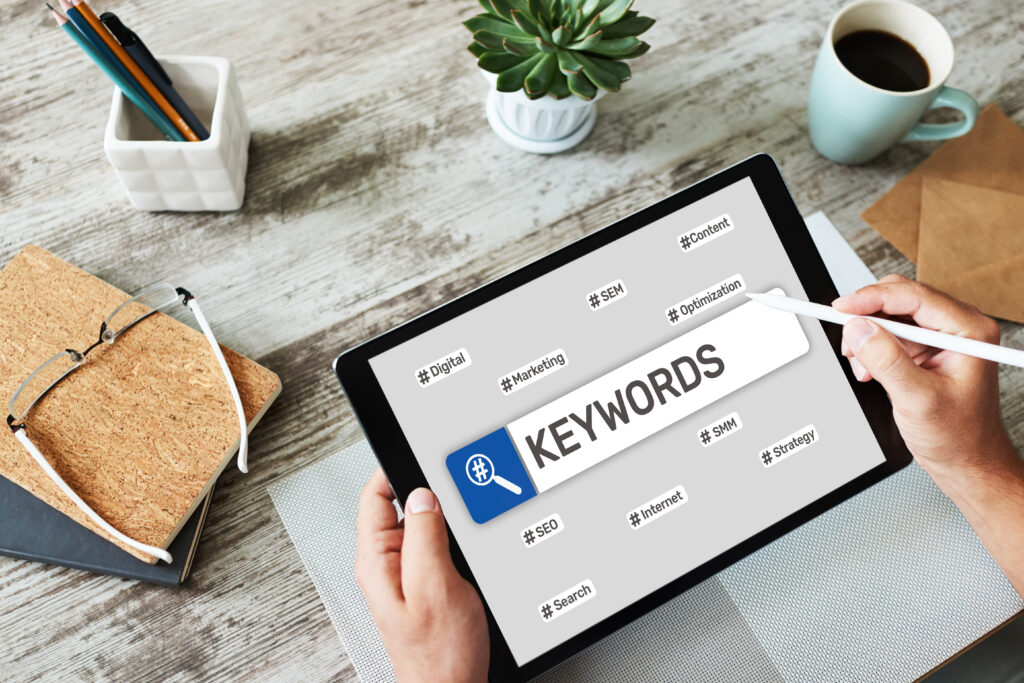Two of the biggest challenges when managing paid search campaigns are sticking to a budget and maximizing return on investment (ROI). The majority (86%) of companies can’t exceed a monthly budget, and 28% of companies manage their spending by setting limits within Google Ads. However, if you can’t exceed how much you spend, how can you keep driving more clicks, engagement, and conversions? PPC teams are constantly pressured to do more with less to stretch their budgets.
Even if you have managed the same paid search account for an extended period, it could be beneficial to audit your campaigns to make sure they are performing as they should. Start with a high-level view of your overall effectiveness, then dive into certain ad groups and targets to ensure you aren’t wasting money. Here are seven signs that you are overspending or bidding on irrelevant terms and concepts.

1. Your Average Cost-Per-Click Exceeds Industry Standards
It doesn’t matter whether you target 10 terms or 10,000; start your audit by reviewing your overall CPC for your campaigns. According to WordStream’s 2023 Search Advertising Benchmarks, the average CPC for automotive sales terms is $2.08, while the average CPC for automotive repair, service, and parts is $3.06.
Your CPCs don’t have to align perfectly with these averages, but they are a good starting point to understand if you are paying more or less than the average automotive business. This data is separated because not all car repair and service companies also sell vehicles. As a dealership, you must compete with other car sales companies in the area and repair shops.
Along with looking at your CPC compared to industry standards, track your costs over the past few years. Determine whether you are spending more to earn each click and evaluate whether that results from campaign waste or other factors, like increased competition because of a new dealership in your area.
2. Increasing CPCs Don’t Correlate to Higher CTRs
The next high-level step in the PPC audit process is to look at your click-thru rates. According to Wordstream, 91% of companies reported an increase in CTR over the past year. There was a minor change for the automotive sales industry (only +0.3%), but the automotive repair, service, and parts sector reported a +4% CTR change on average.
As a whole, automotive companies have competitive CTRs compared to other industries. Overall, Wordstream reports that the average CTR for 2023 was 6.11% for all sectors. This jumps up to 8.77% for automotive sales. On average, automotive repair, service, and parts companies reported a 5.91% CTR on average.
Unfortunately, it’s almost impossible to determine why one industry would have a higher CTR than another. It could be because repair companies have more competition, so the clicks are spread around to more bidders. This data could also reflect where customers are in the buyer journey when they click on an ad.
Use your audit to determine how your CTR has changed over the past year and how it correlated to the evolving CPCs. You don’t want to pay more per click while driving lower CTR rates. This means you are losing efficiency in your PPC campaigns.
3. You Aren’t Targeting Local Customers
One of the easiest ways to reduce your PPC spend is to target local audiences instead of bidding on national terms. Look at your current campaign segments to ensure you are only reaching the most relevant buyers. In the world of car dealerships, you are trying to draw people within your immediate vicinity for repairs and services while also reaching buyers in a greater geographic area to buy from you.
A survey by Kelley Blue Book found the average American is willing to drive 469 miles to score a good deal on a car. This distance varies by state. Residents in Kansas are ready to drive 625 miles, while those living in Vermont are only willing to go 286 miles on average.
As you develop your local campaigns, consider who you will market to and whether using state-level search terms falls within your budget to use state-level search terms. For example, you develop ad groups that use keywords like “car dealership in Omaha” and “pre-owned cars near me,” with geographic limits set in place. You can then test the benefits of creating a “car dealership in Nebraska” campaign to see if you can lure in buyers from across the state.
Creating a local PPC strategy is essential for reducing your overall spending. There’s no reason to compete nationally for exposure when most of your customers are local or regional.
4. Your Quality Scores Need Improvement
Paid search management means working smarter — not harder — to attract customers. You can constantly increase your budget to outspend your competitors, but that still doesn’t mean you are creating quality experiences for potential buyers.
As part of its algorithm, Google Ads assigns a Quality Score that reflects the value that the ad and landing page provide to users. If the ad copy is relevant to the search term and the landing page is useful to whoever clicks on it, then Google will give your keyword a good quality score (usually a score of 8-10 on a scale of 1-10). If the landing page is missing information, has a high bounce rate, or is irrelevant to the user’s search intent, then your quality score for that keyword will be low.
You don’t need to look at every single quality score to audit your paid search campaigns. Instead, sort your keywords by clicks or by monthly spend. You want to focus on the terms that drive the most traffic or that you bid the most on. Then, evaluate the quality scores of these important terms. If your most important keyword has a lower quality score than you would like, you might need to work on the landing page it leads to.
Paid search and SEO teams should not operate in siloes. You will likely work with your search and content departments to improve landing pages and create better experiences for PPC audiences. And these efforts can really pay off. Google awards higher PPC rankings to ads with higher quality scores. They also display these ads at a lower cost. By improving your website content, you can lower your paid search costs while creating more valuable experiences for your audiences.
5. Your Ad Groups Are Clogged With Keywords
Every keyword you add and bid on is a potential traffic driver to your website. However, it’s not uncommon for businesses to have thousands of keywords that never get clicks, making PPC management more complex. Your keywords aren’t exempt from the Pareto Principle, where 20% of your terms will likely drive 80% of your traffic.
You can decide how you want to manage your non-performing keywords. First, you can remove them. You can manage a smaller campaign focusing on specific ad groups and keywords that are already performing. Alternatively, you can break up larger campaigns into smaller ad groups. This might give lesser-used keywords more of an opportunity to stand out and receive clicks. Increasing your ad groups will require more work on your part, but this could also give you a chance to take better control of your ad campaigns.
The optimization plans you move forward with will depend on your personal bandwidth and how your digital marketing team is managed. Few dealerships have time for a complete PPC overhaul unless they have a trusted agency partner to help them through this process.

6. Your Ads Show Up for Irrelevant Search Terms
Besides removing underperforming keywords in your ad groups, look for irrelevant search terms that waste your budget and create poor user experiences. For example, if you bid on the term “local Dodge,” Google might show your ads for people searching for “local dodgeball teams.” No one who is trying to get involved in recreational sports wants to click on a car dealership ad.
Spend some time growing your negative keyword lists so your ads only appear for relevant audiences. You might be surprised by the number of tangential searches your ads are displayed on — and how much wasted budget results from accidental clicks. Not only do these clicks cost you money without driving results, but they can also increase your bounce rate and lower your Quality Score in the long run.
The short-term process of adding negative keywords is well worth the long-term savings and benefits to your campaign quality.
7. You Feel Pressured to Spend More
Google has one singular business objective: get you to spend more money through its ad campaigns. A staggering 80.2% of Google’s annual revenue comes from ad spending. This includes $162.45 billion for Google Ads (58.1%), $32.78 billion for Google Network Ads (11.7%), and $29.24 billion for YouTube ads (10.5%). Bing, Facebook, and other marketing channels also have the same goal. They want to be a significant part of your digital marketing budget.
Naturally, there is some give and take between Google asking you to spend more and delivering clicks and conversions. To an extent, Google must prove that its ad platform is valuable to your brand. This is why it uses concepts like the Quality Score to make you feel like you are getting a good deal. However, as you navigate the ad platform, you might find that Google frequently tries to get users to spend just a little bit more on each ad group to reach their marketing goals.
While it is understandable that Google will try to take more of your money, you shouldn’t expect the same thing from your PPC agency. Some paid search firms pressure clients to spend more, claiming that is the only way to increase conversions. This also becomes a conflict of interest if your agency charges as a percentage of your ad spending. The more you spend with them, the more money they make.
Sometimes, your PPC campaigns can benefit from a budget increase, but this should be the last step of the audit process. You should optimize your campaigns first and look for ways to save money while maintaining efficiency. This allows you to reinvest your funds so your newly-optimized ad groups thrive. Only then can you decide whether adding to your budget would be the right call to grow your dealership business.
Build an Impactful Campaign With a Trusted Partner
Paid search campaigns become more complex as they grow. If you run a car dealership with a service department, you might feel like you are managing multiple campaigns as you target different audiences. Instead of getting overwhelmed by keywords and wasting your budget, work with a team of experts who can target impactful keywords and create valuable segments.
We don’t want you to spend more money. We want you to take the money you have and spend it better. Let us prove our capabilities to you. Learn more about the paid search services at J&L Marketing and contact our team today. We are happy to identify wasted spending in your campaigns so we can give you your budget back.



